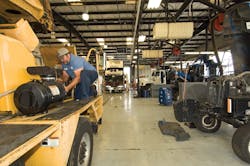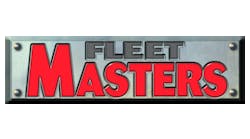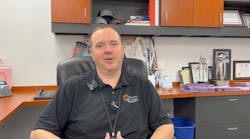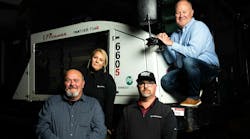It takes skilled management to control a fleet of nearly 2,000 county vehicles and an annual budget of $11.3 million, $2.3 million of which is earmarked for new and replacement equipment.
That challenge, along with fending off competitors from the private sector, makes up the obstacle course run every day by Marilyn Rawlings, CEM. As director of the Lee County Fleet Management Division in Fort Myers, Fla., she has also heeded the advice of an ancient African proverb about gazelles outrunning lions to survive and lions outrunning gazelles to avoid starvation. The moral of the proverb, says Rawlings, is something any fleet professional can easily understand. “It doesn’t matter if you are a lion or a gazelle, when the sun comes up you’d better be running.”
A clear demonstration of how well Rawlings does this came in March. Lee County Fleet Management won the 2010 Fleet Masters Award from the Association of Equipment Management Professionals (AEMP).
One of the reasons Rawlings’ operation walked off with the Fleet Masters Award can be tracked back to a familiar adage: “If you can’t measure it, you can’t manage it.” She has identified six specific benchmarks—all reviewed annually—that enable her to stay on course and to compete with both the public and private sectors of her region.
Preventive maintenance compliance is an industry standard that gives Rawlings a quick snapshot of the condition of the fleet. She sends out a monthly report that tells her customers what vehicles need to be brought in or are past due for PM. The schedule is based on hours or miles, depending on equipment type and application.
“We have liaisons within each department that we work with,” Rawlings says. “If the equipment becomes 30 to 60 days late, I get on the phone and say I need their help. If the equipment still does not come in, we can enforce the compliance by shutting off their access to fuel at our sites.”
The statistics bear out how well this approach works. Less than 5 percent of vehicles are past due, she says, and that’s a 95 to 98 percent PM compliance.
The second benchmark Lee County tracks is reason for repairs, which measures four categories: scheduled, nonscheduled, drive in, and emergency repairs. As an example of the division’s technical ability, it can track rework that comes in. A customer might bring in a vehicle for air conditioning repair and complain that this is the same problem that brought the vehicle into the shop two weeks ago. “We know it could be that or it could be something else,” Rawlings says. “Rather than argue with the customer at the counter, the repair automatically goes to a rework, or come back, status until the unit is fixed and out of here.”
The rework report then goes to a third party—in this case, the shop superintendent—to determine if the repairs were truly rework or something else. “I don’t want the technician making that call,” Rawlings says.
“The importance of reasons for repairs is that we try to keep 80 percent scheduled versus nonscheduled maintenance, which is tough,” says Rawlings. “But we still try. Mostly it is an incident like tires going flat. It’s very seldom that someone is left sitting beside the road; but when it’s you, that’s one too many.”
That leads to a third benchmark, random comparisons of technician hours billed on a work order to industry standards (flat rate times). Individual technicians must generate an average of 1,650 billable hours out of a total of 2,080 hours available each year to meet the financial requirements of the organization.
“In working out billable hours, we use the industry standard, if available, to determine if the repair should take one hour, two hours or 12 hours. Then I know how well a technician is doing,” Rawlings says.
Rawlings recently used this benchmark with one of her technicians. “His times were noticeably much higher on brake repairs,” she says. “I had three options. One, I could fire him, which hopefully I wouldn’t have to do. Two, tell him he could never work on brakes again; or three, give him the extra training he needed to bring him up to the standard required for him to perform.”
Training is the fourth benchmark. “Reasons for repair, random checks, and training all go hand in hand to help me evaluate the technicians and keep my customers satisfied,” Rawlings says.
Her training goal is to provide a minimum of 40 hours of specialized training per employee. “Supervisors track each employee’s training to ensure the individual is provided the information and skills needed to do a great job,” Rawlings says. “Ideally, every employee should have the opportunity to learn something new every day and stretch the way he or she thinks about solving problems.”
The fifth benchmark is turn-around time and reasons for delay. “Our work orders are tracked by shop, by technician, reason for delay, and delay codes,” Rawlings says. When a piece of equipment comes in, it is given an “O” status (for open work order). Rawlings is then able to determine how long a machine has been waiting for service. “Once the technician logs onto the work order, it goes to an ‘A’ status,” she says. “If the technician has to wait for the parts room to get an unusual part, the work order goes to a different, waiting for parts status. When the part comes in, the status is returned to an ‘S’ status, which means it is waiting for a technician.”
Such reports are run every day, and Rawlings closely checks all the non-closed work orders in the shop. “I can see what vehicles are waiting to be picked up, and for how long. If a customer complains that his vehicle has been in the shop too long, I can show him that the vehicle was repaired in a day, but it has been sitting there for three days waiting to be picked up. That helps me identify where we need to do some things better to streamline our operation,” she says.
A small change can sometimes make a big difference. In her facility, the parts department is further from the PM shop than anything else. To the untrained eye, she says, that might not matter. “But technicians are the ones who use parts the most. They have to spend time walking to the parts room, waiting in line with other technicians, then walking back with the part.” An employee suggested that they put a mini parts room right in the PM shop. In reality, it’s only a large cabinet, but it is stocked with fast-moving parts that are checked, inventoried and replenished once a week (or as often as necessary) by the shop supervisor. Rawlings figures that small change alone saves about an hour a day in technician time.
The sixth benchmark is what Rawlings refers to as a “fleet scoreboard.” This measures how quickly vehicles are turned around. Each shop is monitored monthly by the percentage of vehicles in and out in less than 24 hours, 24 to 48 hours, 48 to 72 hours, and longer than 72 hours.
“In this fiscal year, 70 percent of the vehicles were in and out of the shop in less than 48 hours” Rawlings says. “Heavy equipment repairs and accidents accounted for most of the equipment in the over-72 hour category.”
Despite shop efficiency, not every job is done in-house. Some jobs Rawlings doesn’t want to do, such as paint and body work with its EPA regulations, and front-end alignment that is too costly and requires too much equipment. All told, she outsources about 20 percent of the work to “vendor partners,” she says.
Although well aware of what neighboring county and municipal governments charge for repairs, she does not consider them her competitors. Her competition comes from local dealerships or total outsourcing vendors.
Knowing what the private sector charges for its service doesn’t require a network of spies, Rawlings says. “All it takes is to meet with them. Many fleet managers panic at the idea of meeting with outsourcing vendors. I meet with them, not to let them pick my brain, but so I can pick theirs.”
Total outsourcing vendors “usually always come through the back door,” says Rawlings. “They’ll start with county management or a county commissioner who brings them around to meet with me.”
An example of why she doesn’t mind meeting with them happened about six months ago when her boss brought in an outsourcing vendor. The vendor told her if he were running her operation he would do this and that. She replied, yes, we do that, too, and we’ve found it works really well. After going through a myriad of such comments and replies, the vendor gave up, “and right in front of my boss says he had never been in a facility where everything he suggested was already being done,” Rawlings says. “Then he asked if we could recommend someone who might need his services.”
Occasionally, she admits, one of these vendors will come up with a good idea. When that happens, she waits until the vendor leaves and then implements the idea herself.
Rawlings sums up her approach to fleet management this way: “If you are really benchmarking, you include everything, those that you are good at and those you are not so good at. Many managers benchmark only what they do well because they want to look good. But you have to benchmark your weaknesses, too, in order to improve them.”
As in the ancient African proverb, Lee County’s Fleet Management Division knows it had better be running when the sun rises. With her six benchmarks in hand, Marilyn Rawlings makes sure that it is.





